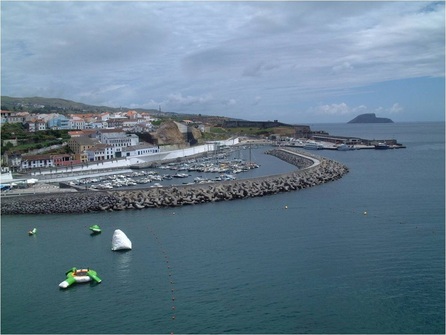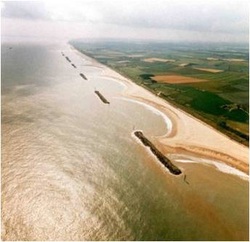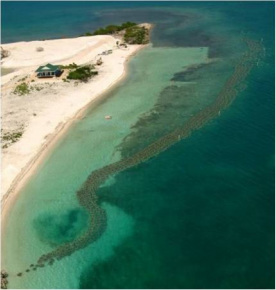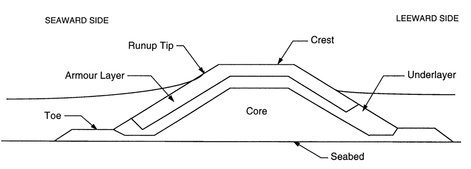Analysis of the Wave Energy Reduction of Rubble Mound Breakwaters
Project Objective
The objective of our project was to further explore information available on breakwaters and to model and test a breakwater to determine the impact that a breakwater has on waves. To further focus our research we decided to look at Rubble Mound breakwaters. Rubble mound breakwaters can be either emerged (visible above the mean water level) or submerged (below the mean water level and invisible). We tested both types of breakwaters for our investigation.
Breakwaters
Purpose
The main purpose of a breakwater is to protect shorelines, harbors, and other vulnerable coastal areas from the effects of wave action and currents that cause cause coastal erosion (Palmer and Christian, 1998).
Types of Breakwaters
There are several different types of breakwaters that are used for different applications along coastlines. The primary distinction between breakwaters is whether they are fixed or non-fixed. A fixed breakwater spans the length of the water column, ascending from the bottom of a body of water to near the mean water level, or a certain design height above the mean water level. A non-fixed breakwater is a design where the topmost portion of it is buoyant and floats on the surface of the water while an extension descends from the surface to a certain design depth, but does not reach the bottom of the body of water. In this way water can pass beneath the breakwater at a depth that is only minimally affected by wave action. Materials used for the construction of breakwaters vary due to the location, coastal environment of the area, and overall design purpose of the structure (Palmer and Christian, 1998). Some fixed types of breakwaters can include rubble mound breakwaters as well as concrete bulkheads. For the purpose of this project we focused on both emerged and submerged rubble mound breakwaters.
The main purpose of a breakwater is to protect shorelines, harbors, and other vulnerable coastal areas from the effects of wave action and currents that cause cause coastal erosion (Palmer and Christian, 1998).
Types of Breakwaters
There are several different types of breakwaters that are used for different applications along coastlines. The primary distinction between breakwaters is whether they are fixed or non-fixed. A fixed breakwater spans the length of the water column, ascending from the bottom of a body of water to near the mean water level, or a certain design height above the mean water level. A non-fixed breakwater is a design where the topmost portion of it is buoyant and floats on the surface of the water while an extension descends from the surface to a certain design depth, but does not reach the bottom of the body of water. In this way water can pass beneath the breakwater at a depth that is only minimally affected by wave action. Materials used for the construction of breakwaters vary due to the location, coastal environment of the area, and overall design purpose of the structure (Palmer and Christian, 1998). Some fixed types of breakwaters can include rubble mound breakwaters as well as concrete bulkheads. For the purpose of this project we focused on both emerged and submerged rubble mound breakwaters.
Rubble Mound Breakwaters

Rubble mound breakwaters are used in a variety of locations. They can be used to protect anchorages as shown in the photograph to the left as well as parallel or perpendicular to shorelines as shown in the photographs at the top of this page (Ranasinghe et al., 2010). Materials used to construct rubble mound breakwaters include: rock, rip rap, and precast concrete armor units. The picture shown below shows a typical cross section of a rubble mound breakwater. The core, shown in the cross section is usually composed of rock fill, and the armor layers are made up of more rock or the concrete armor units. Design for rubble mound breakwaters are often determined by the engineer and usually very site specific. The type of material used in construction often reflects the intensity of the wave action, including average extreme wave heights in the location of the design. Normal practice is to use the precast concrete armor units for extreme average wave heights greater than 5 meters in height. The reason for this practice is that the armor units can interlock together and in that way provide more stability for the structure. For wave heights less than 5 meters, rock or rip rap can be utilized (Palmer and Christian, 1998).
Photo from: http://www.svsarah.com/Sailing/AtlanticCircle/SailTerceira.htm
Rubble mound breakwaters cause reduction in waves in a few ways. The first is in the front slope which decreases energy through friction of the wave running up on the slope of the breakwater. The second is that the conglomeration of rip rap or armor units that make up the breakwater leave open pore spaces. The pore space in the breakwater helps to absorb the water from the waves as the wave hits the breakwater. This ability to absorb the wave energy instead of only reflect is a distinguishing feature of rubble mound breakwaters with respect to other types of breakwaters (Palmer and Christian, 1998).
Photo from: http://www.svsarah.com/Sailing/AtlanticCircle/SailTerceira.htm
Rubble mound breakwaters cause reduction in waves in a few ways. The first is in the front slope which decreases energy through friction of the wave running up on the slope of the breakwater. The second is that the conglomeration of rip rap or armor units that make up the breakwater leave open pore spaces. The pore space in the breakwater helps to absorb the water from the waves as the wave hits the breakwater. This ability to absorb the wave energy instead of only reflect is a distinguishing feature of rubble mound breakwaters with respect to other types of breakwaters (Palmer and Christian, 1998).
Cross section of emerged rubble mound breakwater (Palmer and Christian, 1998)

Emerged Rubble Mound Breakwater
Emerged rubble mound breakwaters, like the one pictured to the left as well as the pictures above on this page, absorb and reduce wave energy on the seaward side which reduces the amount of coastal erosion occurring behind the breakwater. This is depicted in the picture to the left where the beach has developed to the point where it is now touching the breakwater.
There are also certain issues that can be associated with breakwaters. The first of which is that increased erosion can occur to either side of the breakwater due to the reflection of waves off of the edges which can significantly detract from the overall purpose of a project (Ranasinghe and Turner, 2006). A second issue is that they detract from the aesthetics of the coastline. Coastal areas are heavily populated by people who own coastal properties as well as tourists. These groups would prefer not to see large concrete structures or rubble mounds built up just off their coastlines, despite the fact that these structures are necessary in order to preserve and protect the coastline.
Emerged rubble mound breakwaters, like the one pictured to the left as well as the pictures above on this page, absorb and reduce wave energy on the seaward side which reduces the amount of coastal erosion occurring behind the breakwater. This is depicted in the picture to the left where the beach has developed to the point where it is now touching the breakwater.
There are also certain issues that can be associated with breakwaters. The first of which is that increased erosion can occur to either side of the breakwater due to the reflection of waves off of the edges which can significantly detract from the overall purpose of a project (Ranasinghe and Turner, 2006). A second issue is that they detract from the aesthetics of the coastline. Coastal areas are heavily populated by people who own coastal properties as well as tourists. These groups would prefer not to see large concrete structures or rubble mounds built up just off their coastlines, despite the fact that these structures are necessary in order to preserve and protect the coastline.
Photo from: http://www.uwsp.edu/geo/faculty/ozsvath/review_questions/miscellaneous.htm

Submerged Rubble Mound Breakwaters
Submerged rubble mound breakwater are constructed similarly to emerged rubble mound breakwaters. However, instead of their design height being a certain distance above the mean water level, they have a design height that sits below the mean water level. This difference between the two allows for a structure that protects the coastline from erosion without detracting from the aesthetics of the coastline (Ranasinghe et al., 2010). The idea to utilize submerged breakwaters came about through scientists observing the ability of coastal reefs to act as breakwaters offshore of coastlines. Once waves hit coastal reefs, the wave energy is significantly decreased.
Photo from: http://www.artificialreefs.org/Articles/ENNAffiliateNewsWorldsLargest.htm
Submerged rubble mound breakwater are constructed similarly to emerged rubble mound breakwaters. However, instead of their design height being a certain distance above the mean water level, they have a design height that sits below the mean water level. This difference between the two allows for a structure that protects the coastline from erosion without detracting from the aesthetics of the coastline (Ranasinghe et al., 2010). The idea to utilize submerged breakwaters came about through scientists observing the ability of coastal reefs to act as breakwaters offshore of coastlines. Once waves hit coastal reefs, the wave energy is significantly decreased.
Photo from: http://www.artificialreefs.org/Articles/ENNAffiliateNewsWorldsLargest.htm

